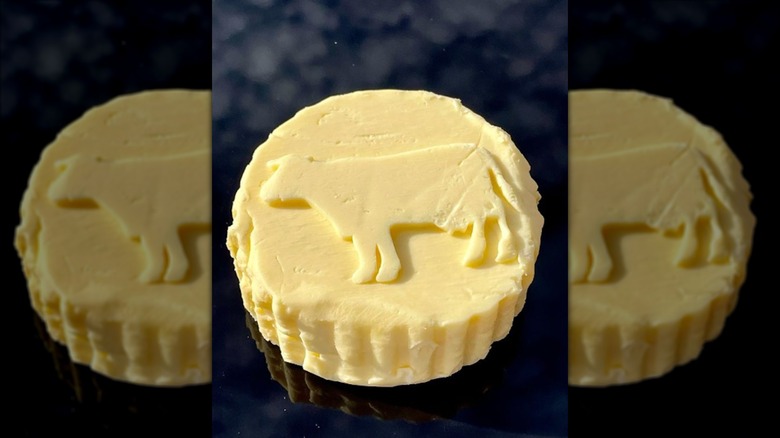Ina Garten Tops Her Toast With The Champagne Of Butter
At exactly 10:30 every morning, the Barefoot Contessa, Ina Garten, sits down to fresh toast with dabs of French butter from Normandy. "It's just so delicious," Garten said about the butter on the podcast "Wiser Than Me" with Julia Louis-Dreyfus. The high-quality butter Garten speaks about is Beurre de Baratte Demi-Sel, one of the most famous French butters in the world. As for the flavor she loves so much, the butter's salt content gives it the savory essence of umami in every bite. But there's more at play than just savory flavor. It also boasts a tangy nuttiness, making its taste profile quite nuanced.
These flavors come from the green grasses and rich soils of the Normandy region that nourish the cows. The French even have a special name for all of this: terroir, meaning "the history of the soil." According to La Cuisine Paris, "rich soil equals rich tasting butter." In other words, if the cows eat good, so do you.
It probably also doesn't hurt that this type of French butter has a mouthfeel that's a bit like cheese. This makes quite a difference when you spread the butter onto bread or toast. Even slightly chilled, the butter won't tear up the bread. It's just the sort of butter you hope to find at the center of a butter board, surrounded by an assortment of artisan and homemade breads.
Making les beurres de baratte
One of the most famous examples of this butter is made by Rodolphe Le Meunier. After securing a supply of milk from local farms in the Loire Valley of France, Le Meunier pasteurizes the milk and ferments it for a day before being introduced to the churn. The distinct tangy flavor of the butter comes from the fermentation process.
In French, "demi-sel" translates as "half salt," which is an important part of the butter's umami profile. "Beurre" means "butter." The real magic, however, comes from the "de baratte" portion of the butter's name. It highlights the butter's hand-churned manufacturing process, which includes the use of an old-fashioned wooden butter churn.
Only about 10% of the butter produced comes from the hand-churned process, according to Elle & Vire, making this toast spread a rarity in the butter world. Everything about it — from the dairy cow stamped on the top of Rodolphe Le Meunier's puck, to its slightly cheesy flavor — smacks of its artisan roots. It's no wonder that Le Meunier has been called a "French butter rock star" by the LA Times.
Is it worth it?
Beurre de Baratte Demi-Sel doesn't come cheap. The Rodolphe Le Meunier brand's price per pound, for example, is over $35, with an 8-ounce round coming in at over $19, per Gourmet Food World. It's expensive enough, in fact, that the Los Angeles-based restaurant, République, charges guests extra for the butter. However, by all accounts, this Champagne of butters is worth the cost. Ina Garten eats it happily on toast, and given that it tastes a little like both butter and cheese, from a flavor perspective, it's probably a bit like having a buttery melted cheese sandwich for breakfast, without all the fuss, calories, and gooey mess.
It also really shines in recipes that boast a heavy butter flavor. Imagine how such a rich butter might enhance the flavor in baked goods, like butter cookies at Christmas, or pasta sauces like Alfredo. By law, French butter must contain 82% butter fat (per La Cuisine Paris). For the rest of the world, 80% is the standard. The 2% difference might seem minuscule, but it's what gives Beurre de Baratte Demi-Sel its velvety texture and ever-so-slightly zesty flavor. It's also why it melts so exquisitely on toast, as the Barefoot Contessa can attest to.


